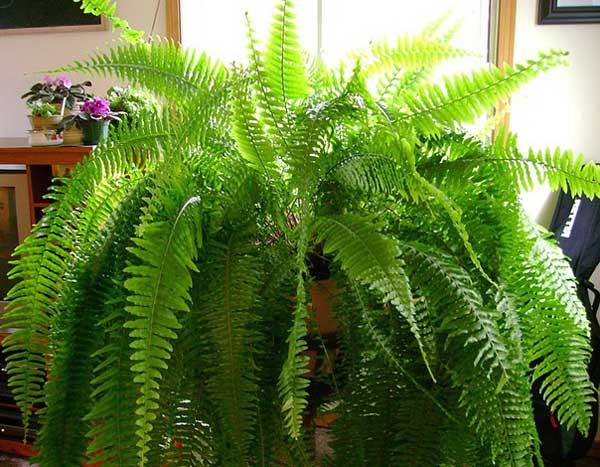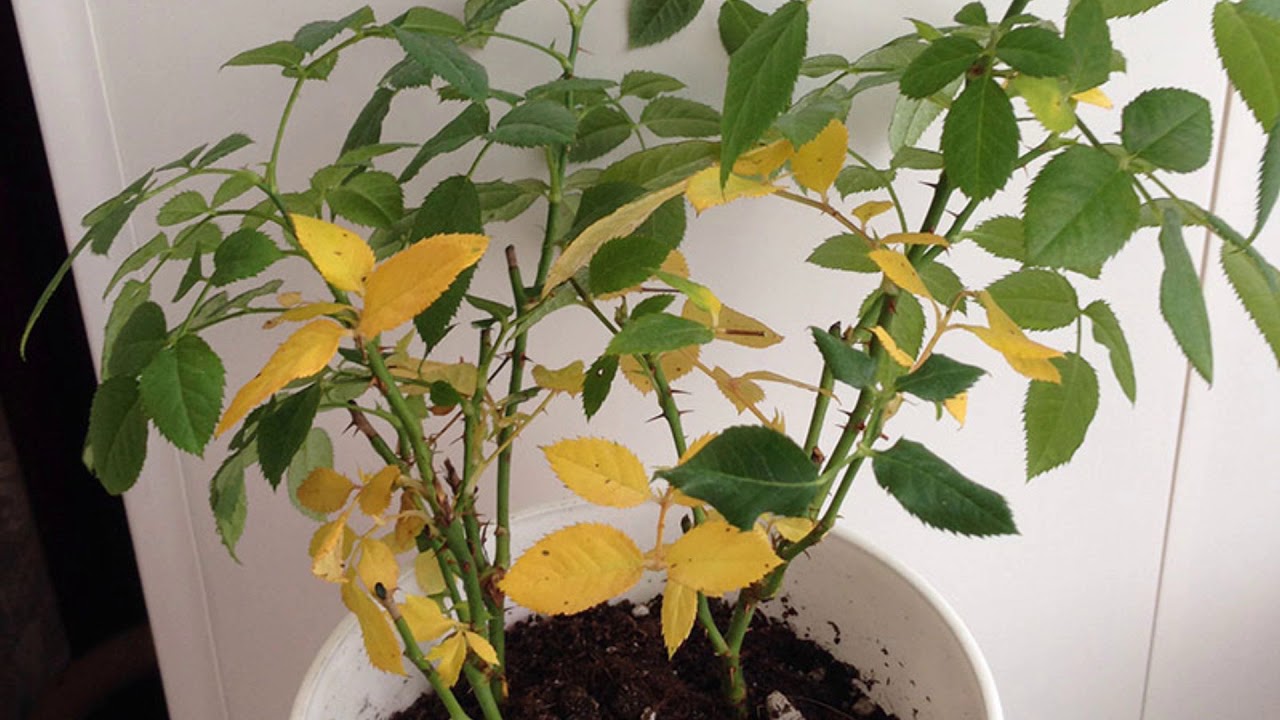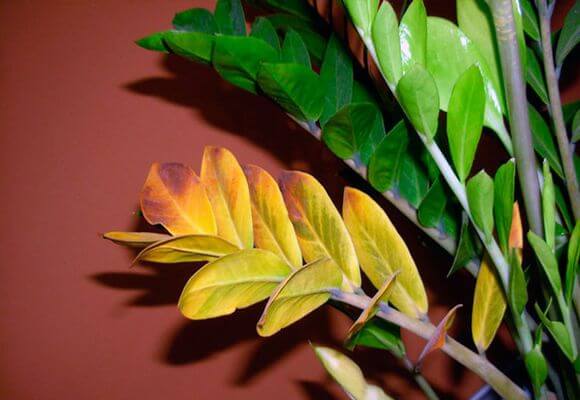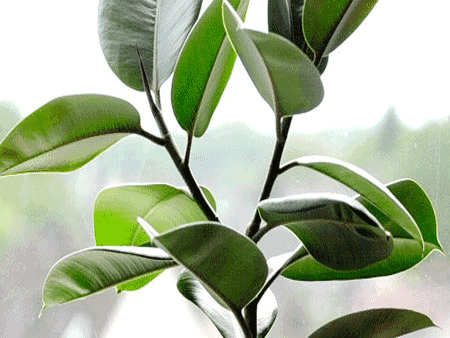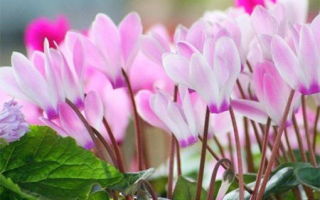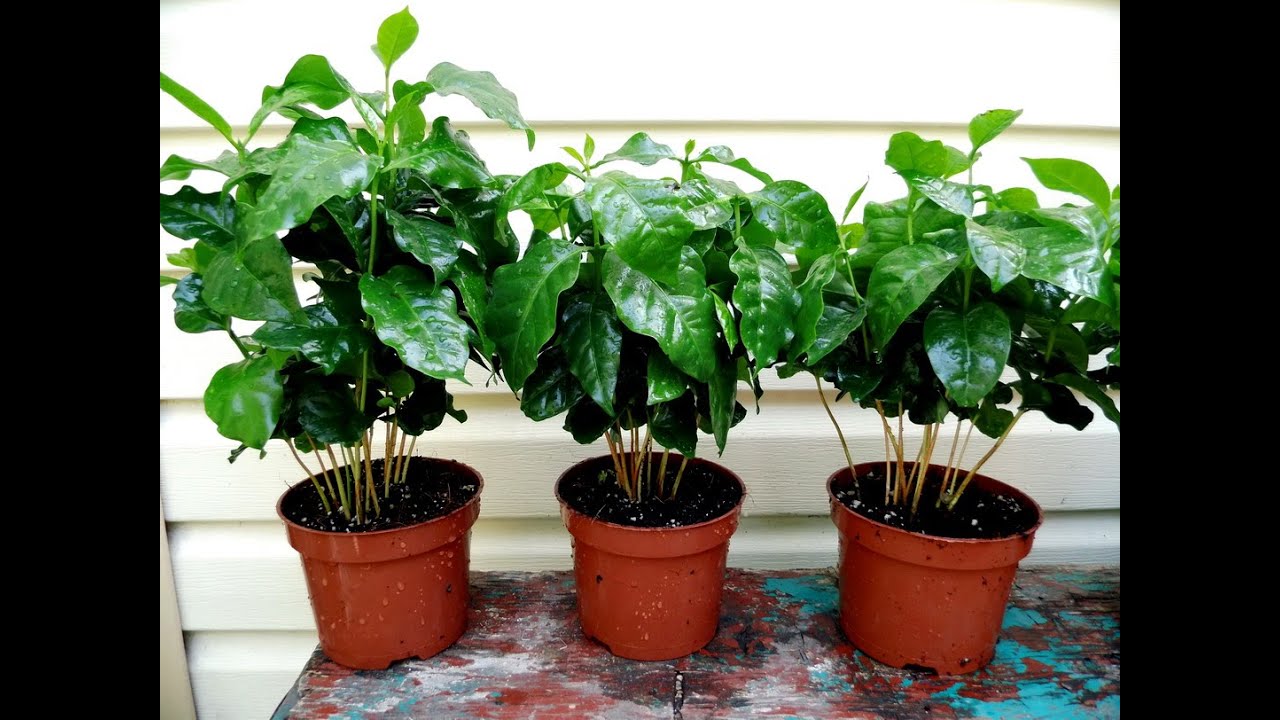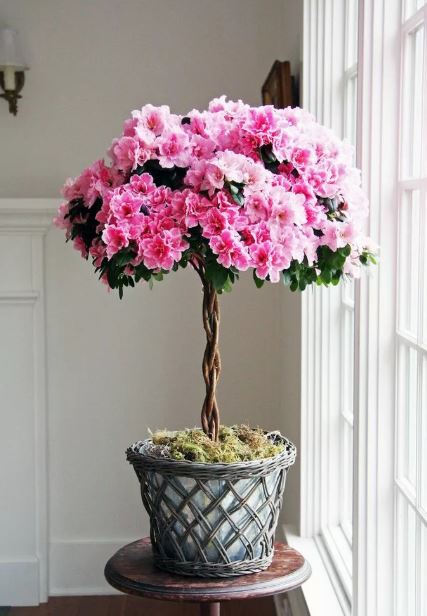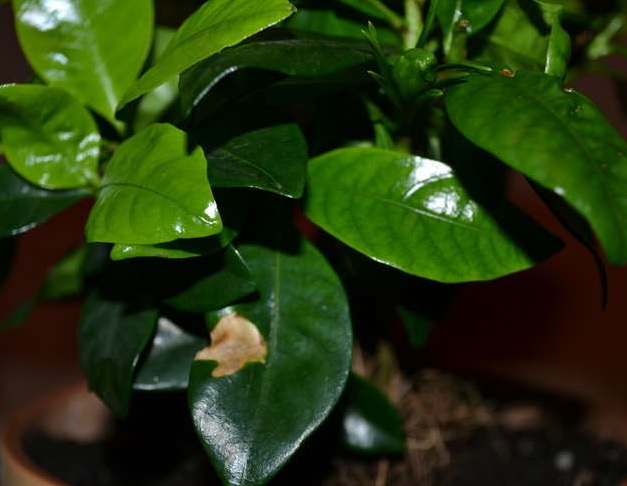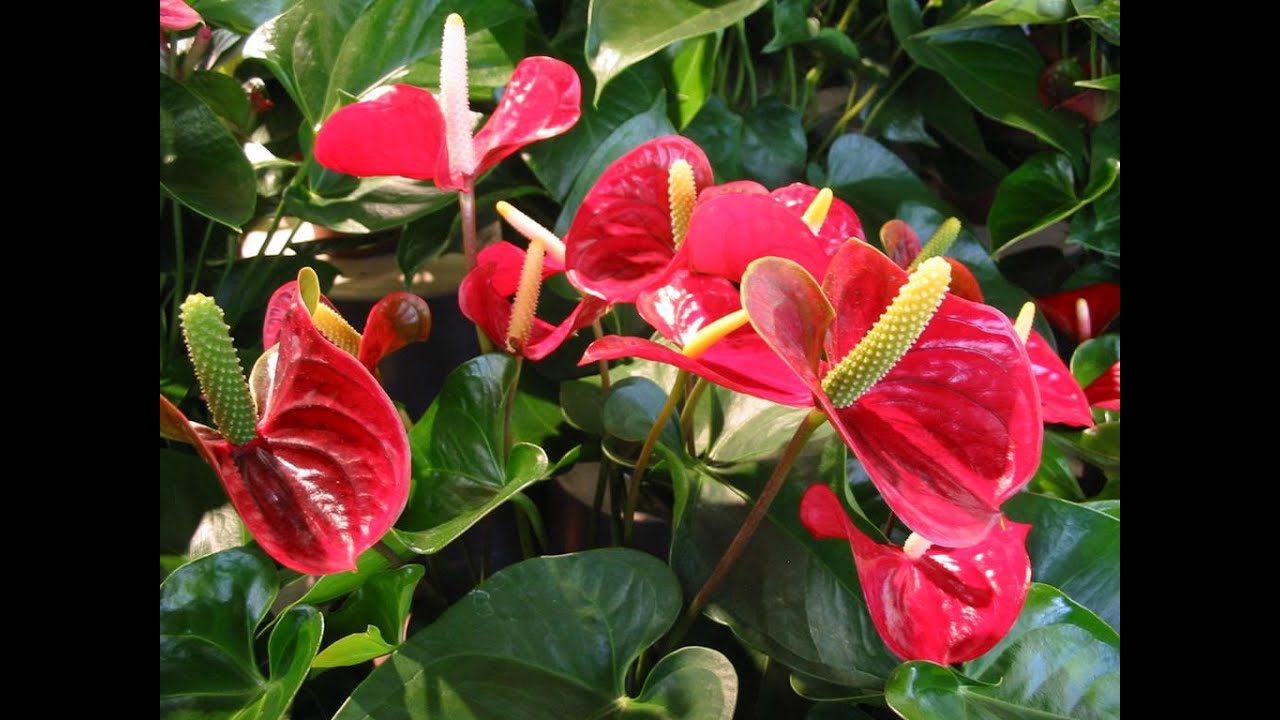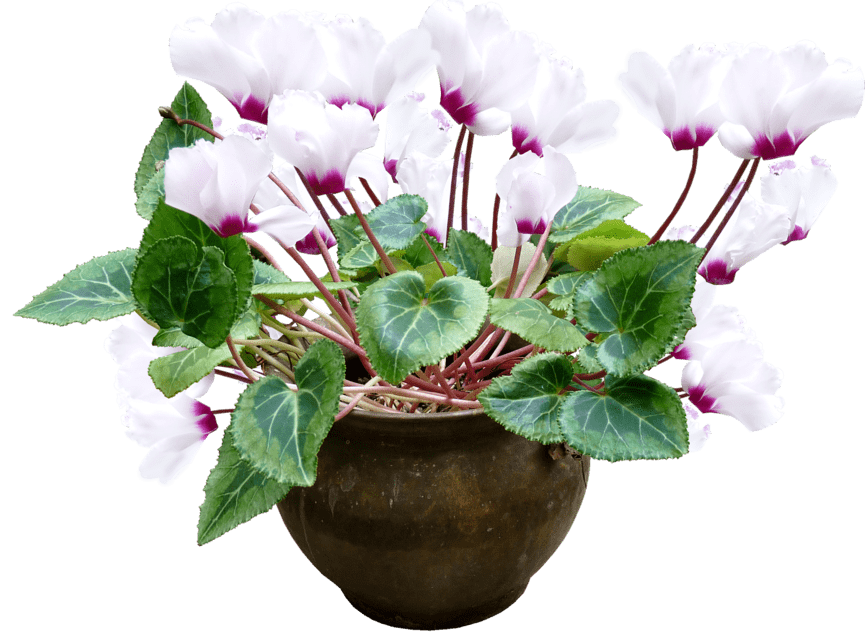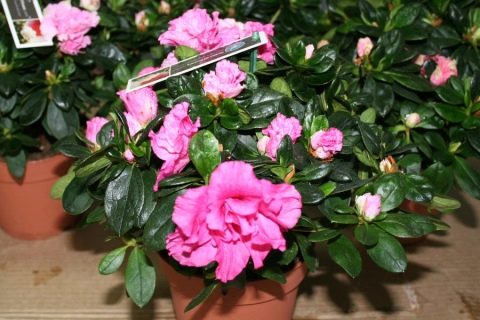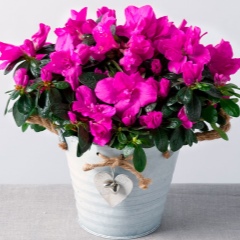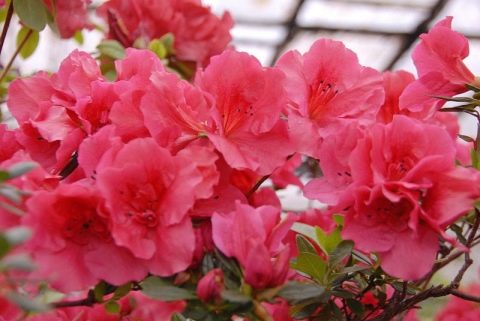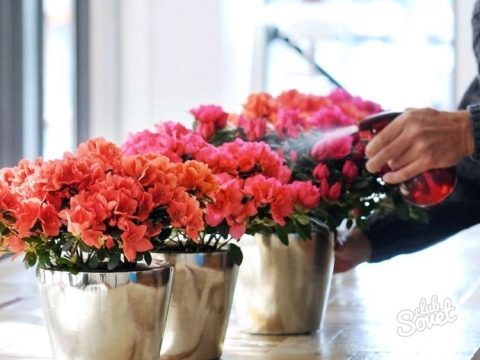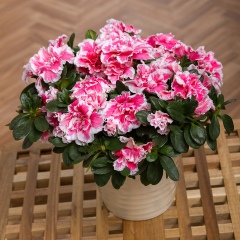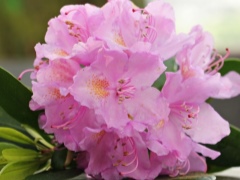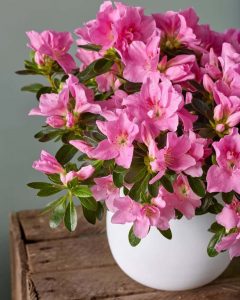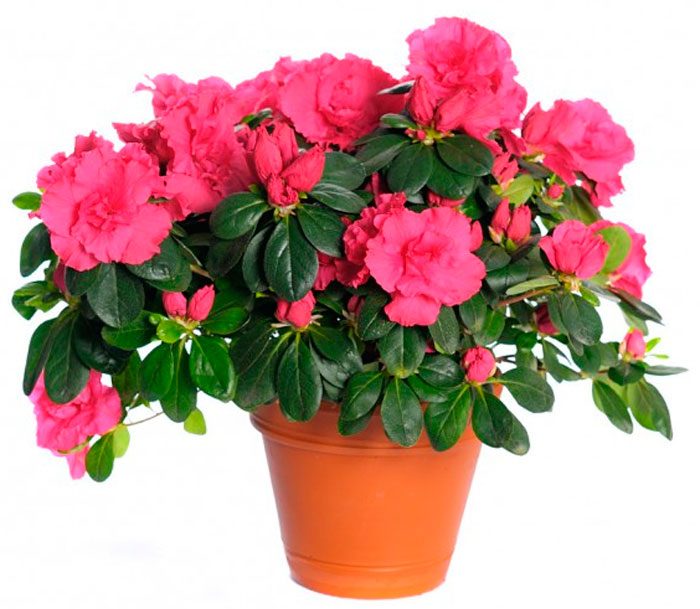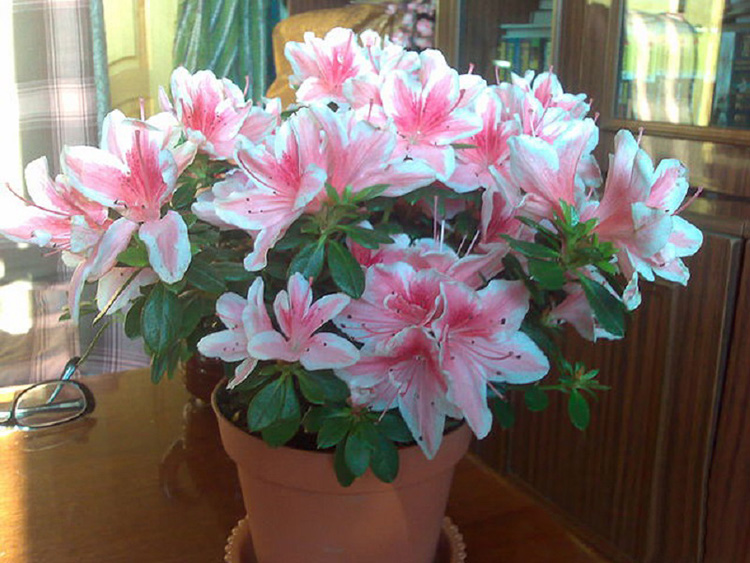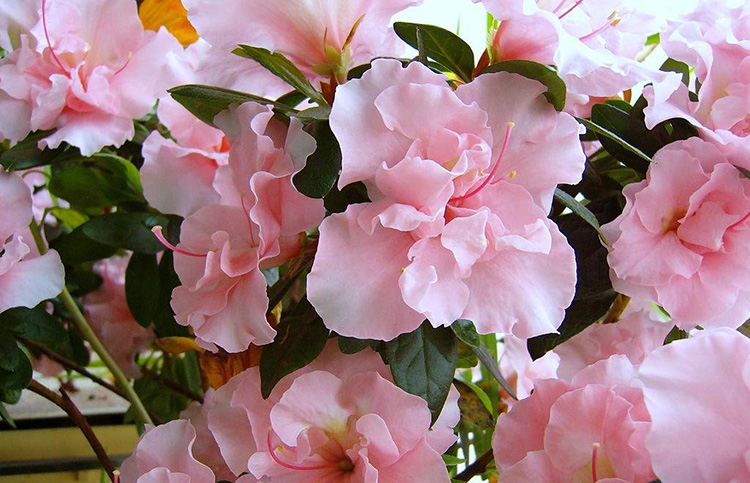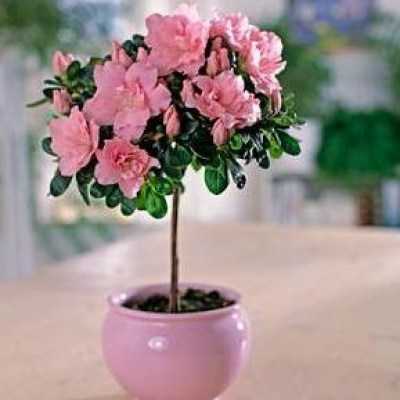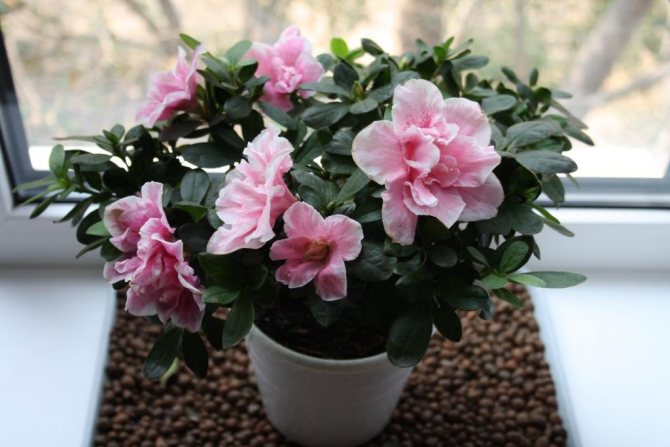How to care to preserve the purchased plant?
Next, we will tell you what to do after you bought the plant.
Do I need to transplant?
The decision to transplant an azalea is made based on the condition of the plant. An early transplant is required only for those flowers that have the following problems during examination:
- Decay, mold or mildew.
- Poor quality soil in the flowerpot.
- The plant is flooded.
- Azaleas became a small pot.
- Root system problems were found.
If none of the above is found, then it is better not to touch the plant until spring. The minimum adaptation period is 2 weeks after purchase. After this time, you can transplant.
How to transplant an azalea:
It is important to take care of the roots: free them from soil containing chemicals. To do this, completely dissolve the Kornevin and Zircon products in warm and soft water.
Gently remove the plant from the pot, cut the lump from the bottom by a centimeter and soak in the solution for 2-3 hours.
Choose a pot for transplanting an azalea shallow and wide. Fill it a third with expanded clay or small stones. Put a thin layer of sand on the drain. Next, add some heather or azalea soil.
Carefully remove the flower from the solution and let it drain.
Place the plant in the center of the flowerpot and cover it with soil up to the root collar.
Sprinkle earth over the roots and add soil to the sides of the earthy ball.
Moisten the soil with Kornevin solution.
The next transplant using the transshipment method will be required in two to three years.
The plant should not be transplanted during dormancy or flowering.
We offer you to watch a video about the nuances of azalea transplant after purchase:
Where to put the pot?
Ideal location criteria:
- Light.
- No direct sunlight. To do this, place the plant next to the windowsill so that the sun's rays come into contact with it through the tulle.
- Cool.
- Wet. Humidify the air with a spray bottle, moss, or indoor fountain.
- It is advisable to isolate the plant from other flowers in the house for two weeks.
- No drafts.
- Away from heating appliances.
Conditions of detention
Optimal conditions of detention:
- Lighting. As already mentioned, azalea loves bright and indirect sunlight. When buying in the warm season, it is allowed to take it out to the balcony in partial shade. In winter, it is necessary to organize supplementary lighting with phytolamps.
- Temperature conditions. The plant needs to be provided with a room without temperature fluctuations. From October to December, it is recommended to place the azalea in a room with a temperature of + 6-10 degrees for the formation of kidneys, and in the rest of the time - up to +17.
- Humidity. The flower requires high humidity conditions. To do this, you can humidify the air with the help of improvised means or pour kermzite into the pan and pour water regularly.
When moistening with a spray bottle, cover the flowers with your hand so that water does not get on the buds.
First watering
After the transplant, the azalea is not moisturized for three to four days. The first watering is carried out with settled boiled or filtered water at room temperature.
Watering is recommended in the morning every three to four days. Water is poured into a pallet, and after 15-20 minutes the excess is drained. You can determine that the plant needs moisture by the weight of the pot: when it becomes light, the flower needs to be watered.
What should i avoid?
Azalea is protected from factors such as:
- Temperature changes, dryness or cold. In winter, make sure that the plant does not come into contact with the frozen glass.
- Excessive watering. Waterlogging can lead to root rot.
- Azalea loves to be cool, but do not pour cold water on it. Overcooling of the root system can lead to fungus or other unpleasant consequences.
Why doesn't azalea bloom?
With improper care and non-observance of the temperature regime, azaleas do not bloom, because flower buds are not bookmarked
It is also important not to rotate the pot with the plant, which is often done by flower growers, so that the bush grows evenly. After flowering, the plant must be pruned by removing excess branches and wilted flowers.
If the azalea has a very thick crown, it will not bloom abundantly.
If the light is too bright and there is direct sunlight, the buds and leaves dry out and become covered with burns. This can also affect flowering. With a lack of light, the same thing happens: then the plant needs to be supplemented with lamps. Air humidity is also of great importance. The presence of pests can interfere with the development of flower buds. One of the factors that affects flowering is a properly selected pot and soil: in a container that is too large and deep, the plant will only grow root mass, and too nutritious or clay soil will negatively affect the azaleas.
Azalea transplant
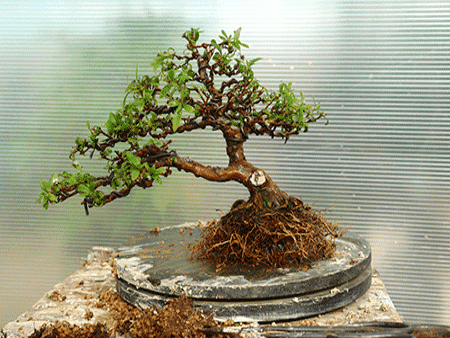
Azalea transplant is not an easy process. If you have ever seen what kind of root system it has, you understand what we are talking about. To transplant an azalea, you first need to be patient. The first and most important thing to learn is that the azalea cannot be transplanted in winter, the chances are good that you will lose it.
After the azalea has faded, we can safely transplant or reload it. The best time to transplant is when young shoots are growing.
Well, now let's go in order
The first step is to select the soil. An earthen mixture for azaleas can be bought at a store, it will cost approximately from 30 to 50 rubles. But if you have the opportunity and desire, you can cook it yourself at home. For this we need: leaf land, coniferous land, heather and peat. Mix everything based on calculations (1: 2: 1: 1). Fine-grained river sand can be used as a baking powder. The resulting soil should be well-drained. If you are transplanting a flower for the first time, we advise you to buy soil in the store, since it is not expensive. Well, with the soil, it became more or less clear. We move on, and the next pot next in line. There are no special requirements for choosing a pot, you can take both clay, ceramic, or even plastic. Perhaps it is only worth saying that if you had a wide but not standard flat pot, take the same one. The main thing is that it should be one size larger than the previous one. Moving on. For the transplant we need:
- A basin of clean water, room temperature.
- Garden pruner or scissors.
- Ready soil.
- Drainage (expanded clay can be used).
Take a pot and pour a layer of drainage about 2 - 3 centimeters high on the bottom. Then carefully remove the azalea from the pot. Remember, at the very beginning we wrote what is the root system of the azalea? Now you yourself have seen this with your own eyes. Next, we immerse the earthen lump in a basin of water for 30 minutes. Then we take it out. We look at how much the earth has separated from the roots, if a little - we immerse it more. And so on until we wash a third of the earth, no more. You can water the lump from a small watering can to speed up the process. The last time we wash the ground with clean water. After a third of the earth has been removed, we carefully examine the root system for rotten roots and other ailments. If there are any, we eliminate it.
Next, we immerse our azalea in a pot and carefully fill it with new soil. Do not fill up the azalea above the level that was before the transplant, otherwise you will fill the root collar. If you think that your soil is still normal, not affected by fungus, mold and other diseases, then just do the transshipment. It is less painful and better tolerated by the plant.
For beginners for the first time, we advise it to do a transshipment, but when you gain experience, study the nature of your specimen, make a transplant.
Transplanting a faded azalea
Annual transplants help the bush to grow actively and enter the growing season in a timely manner. The root system also grows and increases in size, so it is necessary to change the tight container to a more suitable one.
It is imperative to purchase a nutrient substrate special for rhododendrons in advance. But flower growers advise not to spend money on this and make the soil mixture ourselves by mixing loose coniferous soil, river sand, compost and humus.
A step-by-step transplant of a bush into a new container takes place according to the following scheme:
- At the bottom of the pot or bowl, a 4-5 cm layer is placed with expanded clay or brick chips. You can use coarse gravel or small pebbles.
- The azalea is carefully removed from the old container and placed in a container with slightly warm water for half an hour.
- When the roots are soaked, they are carefully washed from the old soil - the main thing is not to damage or leave scratches and cracks.
- If there are dead or rotten areas, they need to be cut off, and the bare areas should be treated.
- Sprinkle a small layer of substrate over the drain in a new container. No need to press down on the ground.
- Place the bush on top and gently straighten all the roots.
- Holding the azalea in an upright position with your hand, gradually cover the entire root of the bush, leaving the root collar on top of the ground. It is necessary to ensure that there are no voids left. Then compact the soil around the stem with your hand.
- To prevent the bush from drying out, be sure to water it with clean, settled water at room temperature.
Since the azalea is very capricious about the transplant procedure, it is necessary to very carefully carry out all the listed steps.
At first, watering should be carried out only after the top layer of the soil has dried.
Attention! Immediately after transplanting, it is better to place the flower pot in a shaded place to avoid direct sunlight.
Azalea flower: care and cultivation at home
When buying an azalea in the store, it is better to choose a plant not with many open flowers, but with closed buds and healthy leaves that are free of spots or damage. It is very difficult to leave discounted plants, therefore, choosing an azalea for long-term maintenance, and not as a living bouquet, it is better not to save money. The flower may look cheerful, but in fact it is already dying.
Some growers even manage to remove the azalea from the pot before buying and examine the roots for decay. Sometimes this is easy enough to do if the flower is dry and is in the transport soil. Very often, in large chain stores, plants are poured: the roots rot and darken at the same time. In a healthy flower, the roots will be light, almost white. Another indicator of health is new buds in the leaf axils.
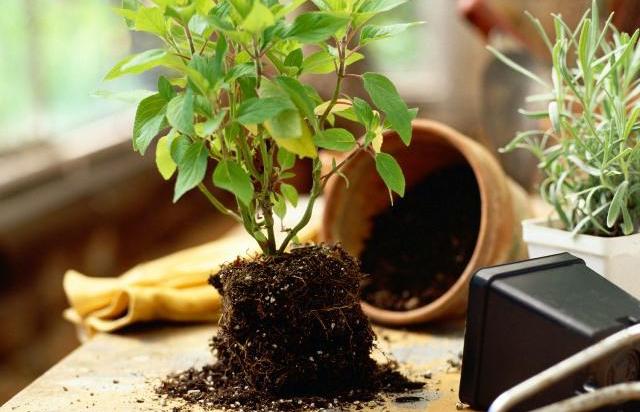
After purchase, the plant must be isolated from the rest for two weeks in order to exclude pest infestation and to allow it to adapt. Can be sprayed with growth stimulants. Sometimes there are several plants in one pot, it is better to separate them during transplantation, but this must be done very carefully, because the root system of azaleas is very delicate. The roots are untangled, clearing the soil in parallel movements. After that, it is recommended to soak the bushes in warm water with stimulants and antifungal drugs.
Success secrets:
For these houseplants the temperature of the content is very important. In summer, it should be 15-18 degrees, and in winter azaleas can withstand a drop of up to 5 degrees Celsius. Optimal for wintering - 10-12 degrees. The dormant period begins in October, when the flower buds ripen. Also, these plants prefer moist air, they like spraying (but without getting water on the flowers).To increase humidity, azaleas are placed next to artificial fountains, air humidifiers, or placed on a large pallet with wet pebbles or expanded clay. The place for the flower is chosen bright, without direct sun, it is better on the north or east window. And a very important question: how to water the azalea? Water the flower sparingly, avoiding the drying out of the earthen coma
It is important not to overflow the plant. In winter, watering is reduced
Water for irrigation needs soft, settled water, a few drops of lemon juice are added to it every 10 days. Fertilize the plant during the laying of flower buds (from May) - once a week with a complex fertilizer for azaleas or flowering plants. Superphosphate can be added in autumn and winter. Some gardeners recommend putting snow in the pot to the azalea - this seems to stimulate flowering. In fact, the effect of such stimulation may turn out to be the opposite - the root system will get overcooled and get sick. The effect of snow is rather related to the positive effect of melt water. Experienced azalea collectors do not recommend this method.
Differences in the content of deciduous and evergreen azaleas after flowering
The fundamental difference from evergreen and semi-evergreen varieties is the absence of photosynthesis in deciduous forms of azalea during dormancy. Therefore, plants that shed their leaves after flowering must be placed in a cold room for a while, regardless of whether there is light in it or not. Most often, flower growers move pots to basements, but some keep them in the refrigerator.
Evergreen bushes do not have a pronounced dormant phase. After the end of flowering, they continue not only to photosynthesize, but also actively grow young shoots. The temperature of the content for them is also reduced, but the illumination is left quite intense.
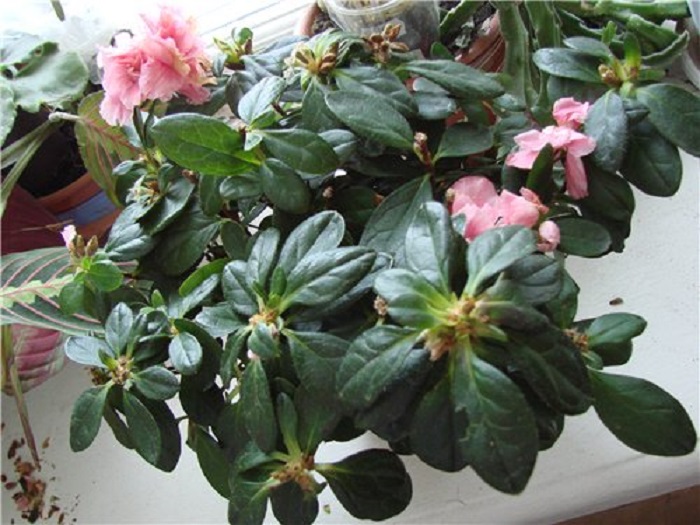 A decrease in air temperature after flowering is a prerequisite for any azalea species. The temperature can be kept at + 5-120C. Watering for the "cold" period is reduced, and spraying is not carried out at all.
A decrease in air temperature after flowering is a prerequisite for any azalea species. The temperature can be kept at + 5-120C. Watering for the "cold" period is reduced, and spraying is not carried out at all.
Azalea diseases and their treatment (with photo)
- It happens that after the purchase, the plants drop their leaves and look wilted. Then they can be covered with a greenhouse, making it from a five-liter bottle. The greenhouse is removed when the azalea starts to grow.
- Loss of color of the upper leaves - chlorosis, iron deficiency. It is recommended to spray the azaleas with iron chelate.
- Yellowing of the upper leaves is a lack of nitrogen. It is necessary to prepare a solution of urea - 2 g per 1 liter of water or ammonium nitrate (3 g per 1 liter).
- A small number of leaves with a red tint, or a red stripe along the edge of the leaf - lack of phosphorus. Can be fed with ash (25 g per 1 l) or superphosphate (6 g per 1 l).
- If the leaves wilt and dry with a brown streak along the edge, there is a lack of potassium. At the same time, a solution of potassium sulfate is introduced into the soil - 2 g per 1 liter of water.
- Fall of new leaves and buds - lack of boron. To compensate for its deficiency, a solution of boric acid or magnesium sulfate (1 g per 1 liter of water) is used.
If you are looking for an answer to the question of how to quickly revive an azalea, read our article on the true miracle of the 21st century: the use of Epin for indoor plants.
From the history of the plant
This indoor flower is an evergreen, branched, flowering dwarf plant. Its homeland is Japan and China, but it can also be found in southern Europe and North America. Indoor azalea belongs to the genus of rhododendrons. Rhododendron from the Greek "rhodon" means a rose, and "dendron" - a tree. Otherwise, it is a rosewood. "Azalea" is translated from the ancient Greek language - dry. It is named so because of its appearance, as a rule, it is a dry small shrub. They appeared in Russia at the beginning of the 20th century, initially they were only in botanical gardens and greenhouses.
In the wild, there are about 350 representatives of azaleas, but there are only two types of indoor ones:
- Indian azalea (most common). It is an evergreen shrub that grows up to 50 cm. Leaves are dark green small with short petioles no more than 3.5 cm in size. They are covered with reddish hairs in azaleas. Such azaleas bloom in winter, their flowers reach a diameter of 3 to 5 cm.
- Japanese azalea is also an evergreen shrub, only 30 to 50 cm high. Its leaves are small, shiny. The main difference from the previous species is the smaller flowers. This shrub can be kept in the garden.
Indoor azalea blooms quite abundantly at the age of 3 to 4 years. She often has bright pink flowers, but often snow-white, rich red, purple, lilac, there are even two-color. The flower petals of a room azalea can be double, slightly double, just even. Azalea leaves are quite small and dark green in color.
When purchasing an intensely blooming indoor azalea, it is better to choose one where there is a significant number of unblown buds, such a plant will quickly adapt to other conditions and will delight with its fabulously beautiful flowers for a long time.
You should also carefully examine the plant for the presence of pests and diseases. By slightly tilting the plant, you can be sure of the presence of dry leaves, which indicates inadequate care, disease.

